There are times when you would want to Sysprep a Windows image and get it ready to join a domain and start creating user profiles. But what if you want to control the configurations and contents of those future profiles?
Windows offers a location for a Default User Profile. It is a hidden folder normally located in %SystemDrive%\Documents And Settings\Default User. To create a default profile all you need to do is log in to the machine, make all the changes you need and then log off. Once you are done copy all the contents of your profile folder to the Default User folder. You will need to do this offline or by using another account.
Profiles folders contain a file called NTUSER.DAT, this file contains all the configurations that are located in the HKEY_CURRENT_USER registry entry when the respective user logs on.
In general all of this works for future profiles even if you are not using Sysprep. But when you do use Sysprep there is a particular case that is not contemplated here. When you set the machine to log in the first time using a particular user account, the contents of that local profile will be copied to the Default User Profile that first time. In those cases you should set the defaults using that account.
One of the best features of the Visual Basic Upgrade Companion, Enterprise Edition, is the fact that it transforms your ADO code into ADO.NET. The Companion converts most of ADO features automatically, and it work correctly even if you choose to generate C# code.
One detail, though, is that the generated code by default uses the SQL Client for ADO.NET connections. This brings huge performance increases to the application, but we’ve run in to the situation in the past where the original datasource was not SQL Server. We’ve seen applications that used the Jet Database Engine, which is no longer supported by the latest version of MDAC, and is definitely not supported by ADO.NET’s SQL Client.
The solution for these scenarios is to use the Microsoft Access Upsizing Wizard. So far we haven’t seen any issues when upsizing the data, but there are other features that are not supported by the wizard. Once you upsize your database into a SQL Server installation (it even works with SQL Server 2005 Express Edition – which is great news for smaller installations), the final step in your application is to update the connection string used. The easiest way to get a hold of the new connection string is to create the connection inside Visual Studio 2005, and then copy the Connection String from the connection’s properties:
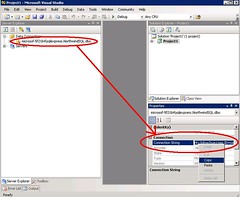
It is also important to mention that this and most other behaviors can be customized through our consulting services. We can also carry out the complete migration process as well.
The self-service portal is one of the best features of System Center Virtual Machine Manager (SCVMM – I have to say I can’t get used to the new name – Carmine still sounds more familiar), as it allows administrators to define policies for creating Virtual Machines, and then users themselves can create new VMs that comply with the limits set by IT (i.e.: Guest OS, amount of RAM, hard drive, etc). This greatly improves the efficiency of IT departments, and allows end-users to take control of the server and workstation provisioning process into their own hands.
During the development of our labs, we run into several issues with the Self-Service portal of SCVMM . After going through all the process to create templates and hardware and guest profiles, we kept running into issues with the template being disabled in the self-service portal. Well, it turns out that the issues had nothing to do with SCVMM itself, but with the configuration on the target Virtual Server. Here are some points in the Virtual Server configuration you should check if you ever run into similar problems (the error messages are not that descriptive):
- The host have enough RAM and disk space for the new VM
- The host must have a default path for Virtual Machines. You can check this one on the web management console of Virtual Server, under Server Properties->Search paths->Default virtual machine configuration folder.
- The host must have sufficient network adapters to support the amount specified in the template.
Our test Virtual Server installation, the default path was missing. Be sure to check these points out if you ever run into a similar situation!
Registration for the Virtualization labs we will be teaching next year is now open. The program will run from December, 2005 to May, 2006, and we will be presenting the content in Redmond, Spain, and several countries in Asia.
The labs are 3 days long, and in them we show you how to leverage the features of Virtual Server 2005 R2 SP1 from a developer perspective. You’ll learn how to script common management tasks, how to use Virtual Server 2005’s API to manipulate virtual machines and develop your own management applications, and how you can setup the System Center Virtual Machine Manager (a.k.a. Carmine) to manage Virtual Server installations.
You can see the complete schedule and sign up for the events at http://www.virtualizationevents.com/ .
Developing XSL can be sometimes cumbersome and tricky. Especially if it is
something you don’t do every day.
Luckily Visual Studio 2005 now provides the an XSL debugger.
To debug an XSL open Visual Studio and open a Project go to the File Menu \
Select New File and Create a New XSLT file.
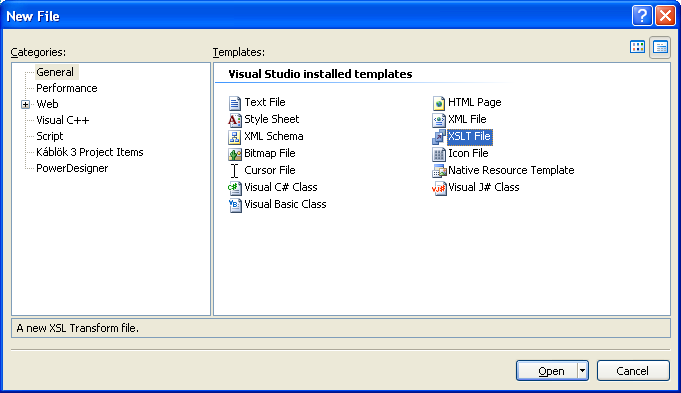
Write your XSL file.
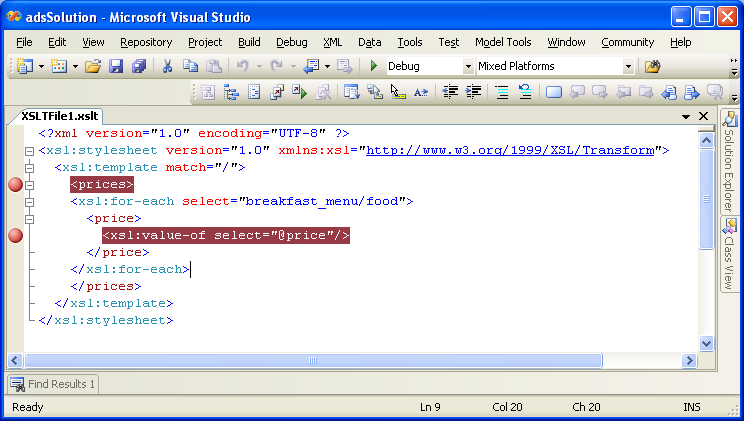
You can set breakpoints just by clicking on the left side of the editor just
like you do for VB.Net of C#.
Now to test it right click on the editor and select properties:
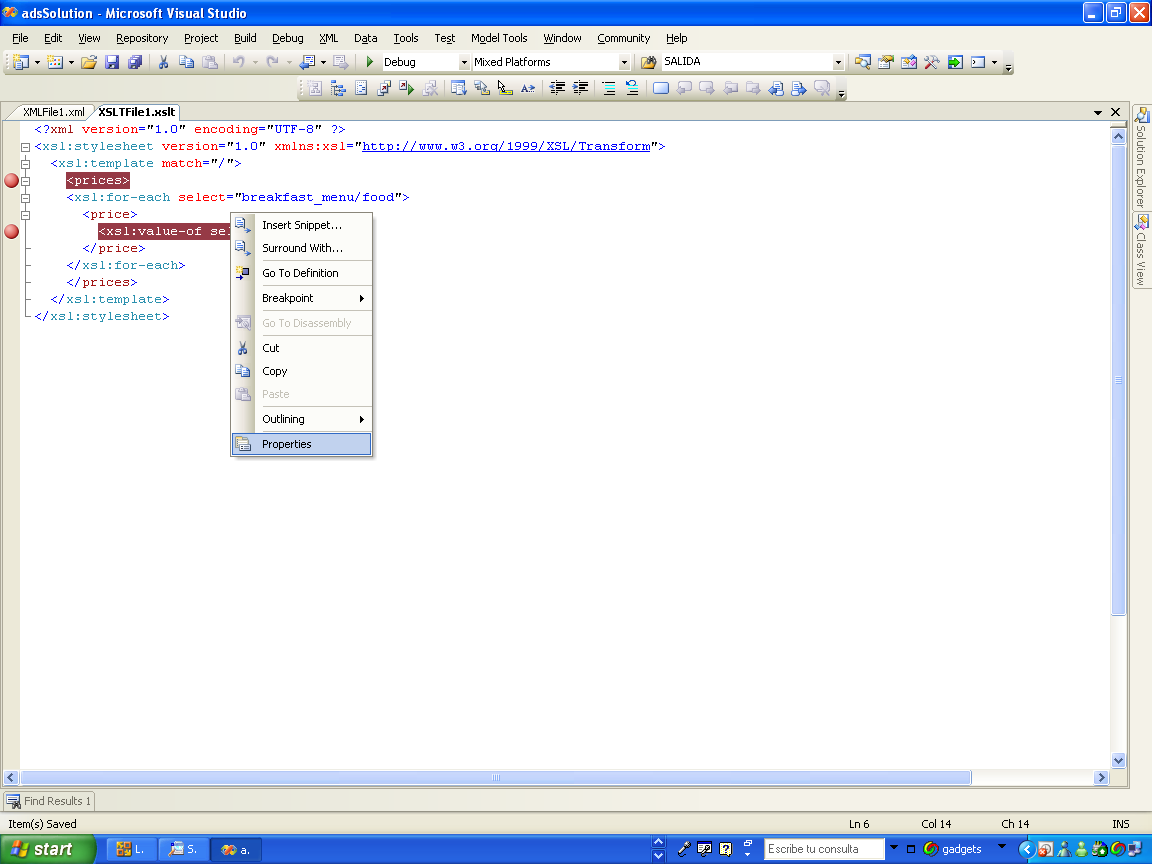
In the properties for the XSL type a name on the
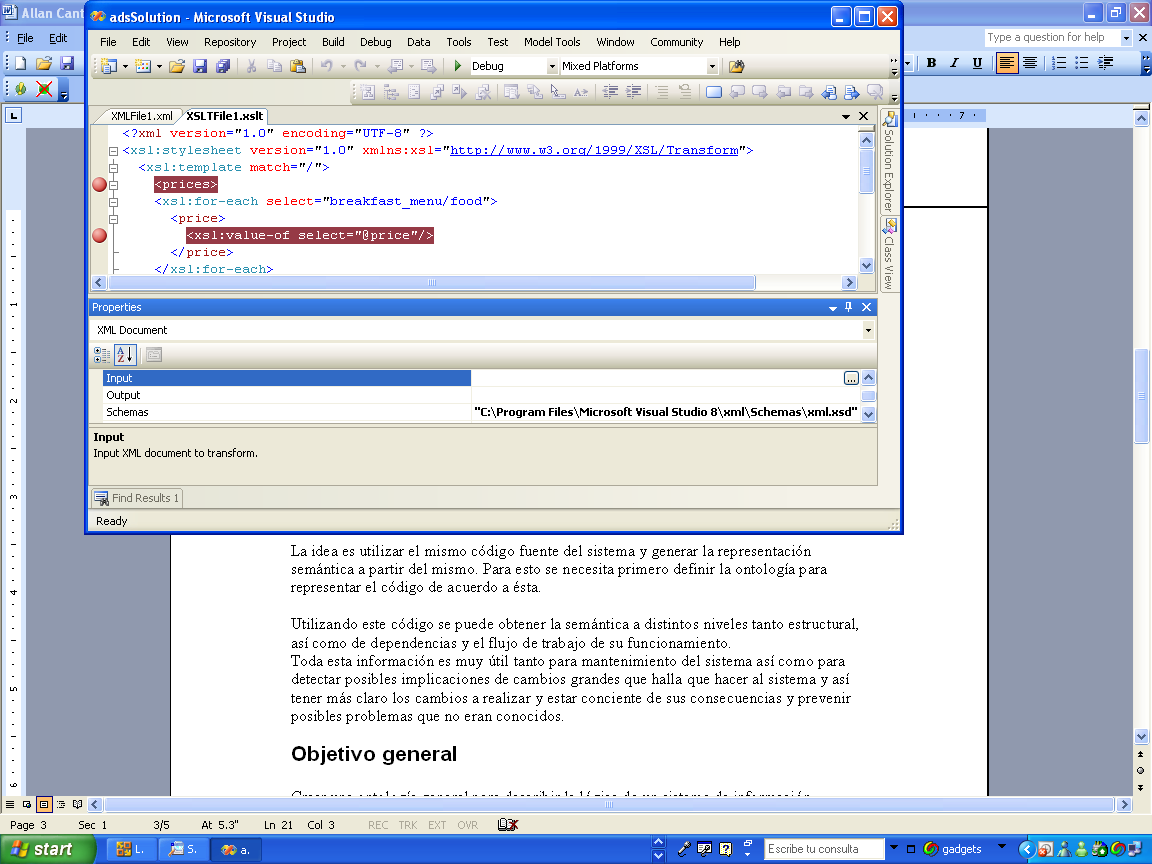
The XML menu provides two options:
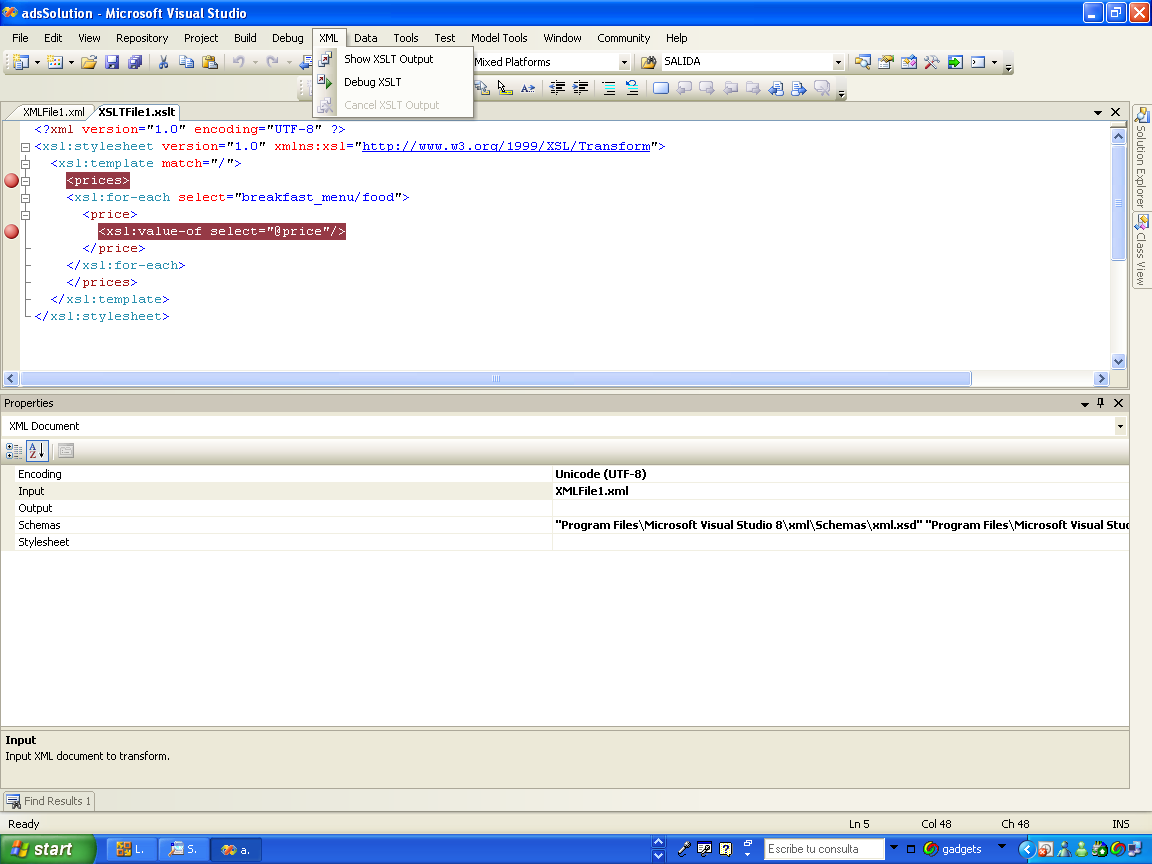
The Show XSLT output will run the complete XSL and let the XSL Output in a new
window. The output by default is not formatted. You can go to the
Edit\Advanded\FormatDocument option to format it.
The Debug XSLT option will start the debugger and stop in the breakpoints you
specified.

Press F10 or F11 to dig into the file. You can use the call stack windows and
even the vales for variables in the Quick Watch and Watch Windows.
You can write XPAth Expression in the Quick Watch Dialog.
There are three special values that are handy when debugging:
last() is the context size, position() is the position, or index
number, of the context node, relative to the context size; and
self::node() is the value of the context node.
And enjoy your debugging experience ;)
A couple of weeks ago I made a post about pre-configured virtual machine images. Well, it turns out that the program is now official, and it is called VHD Test Drive. You can read about it in this press release. With this program, you can download virtual machine VHDs that contain pre-configured Microsoft’s server products, so you can try them out easily. Third party support for the program is expected later. From the press release:
These virtual machines, which are provided in Microsoft’s virtual hard disk image format, are pre-built and pre-configured so that they can be downloaded or distributed for easy setup and evaluation. This allows customers to evaluate software in a fraction of the time it usually takes, such as setting up SQL Server 2005 in minutes instead of hours.
The VHD Test Drive Program is a first for Microsoft software and the more than 7,000 software vendors who can now deliver pre-configured applications within Windows Server-based virtual machines to their customers. Today the program launches with the latest versions of Windows Server 2003 R2 Enterprise Edition, SQL Server 2005 Enterprise Edition SP1, Microsoft Exchange Server 2007 (32-bit beta) with Microsoft Office Live Communications Server 2005, and Internet Security & Acceleration (ISA) 2006 Standard Edition. Partners and customers can expect to see additional Microsoft software added to this program.
You can check out the press release here, and read more about the program on the VHD Test Drive page.
After more than 3 years of managing migration projects here in ArtinSoft, I have decided to start this Project Management blog. In this blog, I would like to share some of the experiences and knowledge that we have accumulated during this time on how to deal with the complex task of leading an application migration project. I hope that the information posted here can be useful to Project Managers and Development Leaders that are in charge of migration projects.
Please stay tuned!
Even though there are not many Macs at Artinsoft (2, I believe :) this might come in handy for someone who needs an efficient remote desktop connection. Even though Microsoft makes a
RDC client for Macs, running it on an Intel mac can be a bit of a drag. Rosetta apps (applications that do not run natively on Intel macs) are kinda sluggish when launching. Also, if you need to run various instances of RDC, you would need to make copies of the app itself (or use
this utility).
Luckily, there are various free alternatives out there that work like a charm. My personal favorite is
CorD (cocoa remote desktop). It is lightweight, fast, free, and offers tabbed windows for various simultaneous connections. The only con I have found so far is that it does not support copy paste.
You can also use
TSClient, which has more features than CorD but unfortunately requires the installation of x11. While this may not be a big issue, some people are not very fond of running programs under x11 for performance reasons. TSClient is the client that most resembles the official Microsoft client and it even offers several features that the official client does not have.
The race between Microsoft and VMWare for the virtualization space can only offer benefits to the end user. The close competition will push the limits of both Microsoft and VMWare in offering the best of each other. Point in case is the (beta) release VMWare's Converter.
The VMWare converter makes the process of moving a physical machine to a virtual a painless process. So far in our tests, we've managed to hack our way with some
unconventional methods, but these take a lot of time. The VMWare tools offers a new level of Physical to Virtual (P2V) conversion by having a manager that can queue operations for this process. It is fully scriptable as well, which can only simply and make the whole process more efficient for system administrators.
Microsoft is not falling behind in this area. The Virtual Machine Manager has plans for not only fully automating P2V conversions but guiding you on the best Virtual Server where the new physical machine can be. Unfortunately, this is not currently supported at the beta stage that the product is right now, but from demos I have seen I am sure it will be a sure contender to VMWare's offerings.
For more info on VMWare's Converter visit
this page and for Microsoft's Virtual Machine Manager info, check
this site out.
Artinsoft provides means to migrated Java Applications to .NET. However as with many medium size to large applications it could be a complex task.
Sometimes due to cost or time restrictions just a portion of the system is migrated. The migration team analyses the code and determines which are the "connection points" or the areas where both systems are connected and therefore, means must be develop to provide communications between the Java and the .NET world.
There are many alternatives.
If you're facing this problem I will recommend the following references:
Microsoft .NET and J2EE Interoperability Toolkit by Simon GuestHe also published an interesting
article where he recommends a products like
Javena, and
JNBridge You can also check out
JIntegra
I recently checkout
NCover http://www.ncover.org/
NCover is a code coverage analysis tool for .NET applications that
gives line-by-line code coverage statistics.
This is an open source tool.
It generetes a nice graphical output about the functions used and not used.
You can see data like:
* how many times a function is called and
* start and end line numbers of the functions
* unused properties of assembly
You can find the beginner level tutorial at,
http://blog.dotnetwiki.org/archive/2004/07/15/594.aspx
Usually in .NET you end up writing code either in VB.NET or C# depending on your clients preferences.
So you usually end up in a situation where you know how to do something in C# but do not remember the syntax in VB.NET or viceversa.
Well I found the following article and I'm copying it here (I had some problems with the link so I decided to copy it).
I want to make clear that I DID NOT WROTE THIS because I do not want to take credit for other peoples work. and it was taken from http://www.harding.edu/USER/fmccown/WWW/vbnet_csharp_comparison.html
"This is a quick reference guide to highlight some key syntactical differences between VB.NET (version 2) and C#. Hope you find this useful!
Thank you to Tom Shelton, Fergus Cooney, Steven Swafford and others for your contributions. "
|
|
Imports System
Namespace Hello
Class HelloWorld
Overloads Shared Sub Main(ByVal args() As String)
Dim name As String = "VB.NET"
If args.Length = 1 Then name = args(0)
Console.WriteLine("Hello, " & name & "!")
End Sub
End Class
End Namespace |
using System;
namespace Hello {
public class HelloWorld {
public static void Main(string[] args) {
string name = "C#";
if (args.Length == 1)
name = args[0];
Console.WriteLine("Hello, " + name + "!");
}
}
} |
|
|
|
|
|
|
|
Boolean
Byte
Char
Short, Integer, Long
Single, Double
Decimal
Date
Object
String
Dim x As Integer
Console.WriteLine(x.GetType())
Console.WriteLine(GetType(Integer))
Console.WriteLine(TypeName(x))
Dim d As Single = 3.5
Dim i As Integer = CType(d, Integer)
i = CInt(d)
i = Int(d)
|
bool
byte, sbyte
char
short, ushort, int, uint, long, ulong
float, double
decimal
DateTime
object
string
int x;
Console.WriteLine(x.GetType());
Console.WriteLine(typeof(int));
Console.WriteLine(x.GetType().Name);
float d = 3.5f;
int i = (int)d;
|
|
|
| Const MAX_STUDENTS AsInteger = 25
ReadOnly MIN_DIAMETER As Single = 4.93
|
constint MAX_STUDENTS = 25;
readonly float MIN_DIAMETER = 4.93f;
|
|
|
Enum Action
Start
[Stop]
Rewind
Forward
End Enum
Enum Status
Flunk = 50
Pass = 70
Excel = 90
End Enum
Dim a As Action = Action.Stop
If a <> Action.Start Then _
Console.WriteLine(a.ToString & " is " & a)
Console.WriteLine(Status.Pass)
Console.WriteLine(Status.Pass.ToString()) |
enum Action {Start, Stop, Rewind, Forward};
enum Status {Flunk = 50, Pass = 70, Excel = 90};
Action a = Action.Stop;
if (a != Action.Start)
Console.WriteLine(a + " is " + (int) a);
Console.WriteLine((int) Status.Pass);
Console.WriteLine(Status.Pass); |
|
|
|
= < > <= >= <>
+ - * /
Mod
\
^
= += -= *= /= \= ^= <<= >>= &=
And Or Not << >>
AndAlso OrElse And Or Xor Not
Note: AndAlso and OrElse perform short-circuit logical evaluations
& +
|
== < > <= >= !=
+ - * /
%
/
Math.Pow(x, y)
= += -= *= /= %= &= |= ^= <<= >>= ++ --
& | ^ ~ << >>
&& || & | ^ !
Note: && and || perform short-circuit logical evaluations
+
|
|
|
|
greeting = IIf(age < 20, "What's up?", "Hello")
If age < 20 Then greeting = "What's up?"
If age < 20 Then greeting = "What's up?" Else greeting = "Hello"
If x <> 100 And y < 5 Then x *= 5 : y *= 2
If x <> 100 And y < 5 Then
x *= 5
y *= 2
End If
If whenYouHaveAReally < longLine And _
itNeedsToBeBrokenInto2 > Lines Then _
UseTheUnderscore(charToBreakItUp)
If x > 5 Then
x *= y
ElseIf x = 5 Then
x += y
ElseIf x < 10 Then
x -= y
Else
x /= y
End If
Select Case color
Case "pink", "red"
r += 1
Case "blue"
b += 1
Case "green"
g += 1
Case Else
other += 1
End Select
|
greeting = age < 20 ? "What's up?" : "Hello";
if (age < 20)
greeting = "What's up?";
else
greeting = "Hello";
if (x != 100 && y < 5) {
x *= 5;
y *= 2;
}
if (x > 5)
x *= y;
else if (x == 5)
x += y;
else if (x < 10)
x -= y;
else
x /= y;
switch (color) { // Must be integer or string
case "pink":
case "red": r++; break;
case "blue": b++; break;
case "green": g++; break;
default: other++; break;
}
|
|
|
|
While c < 10
c += 1
End While |
Do Until c = 10
c += 1
Loop
|
Do While c < 10
c += 1
Loop |
For c = 2 To 10 Step 2
Console.WriteLine(c)
Next
|
|
Do
c += 1
Loop While c < 10 |
Do
c += 1
Loop Until c = 10 |
Dim names As String() = {"Fred", "Sue", "Barney"}
For Each s As String In names
Console.WriteLine(s)
Next
Dim i As Integer = 0
While (True)
If (i = 5) Then Exit While
i += 1
End While
For i = 0 To 4
If i < 4 Then Continue For
Console.WriteLine(i)
Next
|
while (c < 10)
c++;
for (c = 2; c <= 10; c += 2)
Console.WriteLine(c);
do
c++;
while (c < 10);
string[] names = {"Fred", "Sue", "Barney"};
foreach (string s in names)
Console.WriteLine(s);
int i = 0;
while (true) {
if (i == 5)
break;
i++;
}
for (i = 0; i < 5; i++) {
if (i < 4)
continue;
Console.WriteLine(i);
}
|
|
|
|
Dim nums() As Integer = {1, 2, 3}
For i As Integer = 0 To nums.Length - 1
Console.WriteLine(nums(i))
Next
Dim names(4) As String
names(0) = "David"
names(5) = "Bobby"
ReDim Preserve names(6)
Dim twoD(rows-1, cols-1) As Single
twoD(2, 0) = 4.5
Dim jagged()() As Integer = { _
New Integer(4) {}, New Integer(1) {}, New Integer(2) {} }
jagged(0)(4) = 5
|
int[] nums = {1, 2, 3};
for (int i = 0; i < nums.Length; i++)
Console.WriteLine(nums[i]);
string[] names = new string[5];
names[0] = "David";
names[5] = "Bobby";
string[] names2 = new string[7];
Array.Copy(names, names2, names.Length);
float[,] twoD = new float[rows, cols];
twoD[2,0] = 4.5f;
int[][] jagged = new int[3][] {
new int[5], new int[2], new int[3] };
jagged[0][4] = 5;
|
|
|
|
Sub TestFunc(ByVal x As Integer, ByRef y As Integer, ByRef z As Integer)
x += 1
y += 1
z = 5
End Sub
Dim a = 1, b = 1, c As Integer
TestFunc(a, b, c)
Console.WriteLine("{0} {1} {2}", a, b, c)
Function Sum(ByVal ParamArray nums As Integer()) As Integer
Sum = 0
For Each i As Integer In nums
Sum += i
Next
End Function
Dim total As Integer = Sum(4, 3, 2, 1)
Sub SayHello(ByVal name As String, Optional ByVal prefix As String = "")
Console.WriteLine("Greetings, " & prefix & " " & name)
End Sub
SayHello("Strangelove", "Dr.")
SayHello("Madonna")
|
void TestFunc(int x, ref int y, out int z) {
x++;
y++;
z = 5;
}
int a = 1, b = 1, c; // c doesn't need initializing
TestFunc(a, ref b, out c);
Console.WriteLine("{0} {1} {2}", a, b, c);
int Sum(params int[] nums) {
int sum = 0;
foreach (int i in nums)
sum += i;
return sum;
}
int total = Sum(4, 3, 2, 1); // returns 10
void SayHello(string name, string prefix) {
Console.WriteLine("Greetings, " + prefix + " " + name);
}
void SayHello(string name) {
SayHello(name, "");
}
|
|
|
|
vbCrLf, vbCr, vbLf, vbNewLine
vbNullString
vbTab
vbBack
vbFormFeed
vbVerticalTab
""
Dim school As String = "Harding" & vbTab
school = school & "University"
Dim letter As Char = school.Chars(0)
letter = Convert.ToChar(65)
letter = Chr(65) Dim word() As Char = school.ToCharArray()
Dim msg As String = "File is c:\temp\x.dat"
Dim mascot As String = "Bisons"
If (mascot = "Bisons") Then
If (mascot.Equals("Bisons")) Then
If (mascot.ToUpper().Equals("BISONS")) Then
If (mascot.CompareTo("Bisons") = 0) Then
Console.WriteLine(mascot.Substring(2, 3))
If ("John 3:16" Like "Jo[Hh]? #:*") Then
Imports System.Text.RegularExpressions
Dim r As New Regex("Jo[hH]. \d:*")
If (r.Match("John 3:16").Success) Then
Dim dt As New DateTime(1973, 10, 12)
Dim s As String = "My birthday: " & dt.ToString("MMM dd, yyyy")
Dim buffer As New System.Text.StringBuilder("two ")
buffer.Append("three ")
buffer.Insert(0, "one ")
buffer.Replace("two", "TWO")
Console.WriteLine(buffer)
|
\n, \r
\t
\\
\"
string school = "Harding\t";
school = school + "University";
char letter = school[0];
letter = Convert.ToChar(65);
letter = (char)65; char[] word = school.ToCharArray();
string msg = @"File is c:\temp\x.dat";
string msg = "File is c:\\temp\\x.dat";
string mascot = "Bisons";
if (mascot == "Bisons")
if (mascot.Equals("Bisons"))
if (mascot.ToUpper().Equals("BISONS"))
if (mascot.CompareTo("Bisons") == 0)
Console.WriteLine(mascot.Substring(2, 3));
using System.Text.RegularExpressions;
Regex r = new Regex(@"Jo[hH]. \d:*");
if (r.Match("John 3:16").Success)
DateTime dt = new DateTime(1973, 10, 12);
string s = "My birthday: " + dt.ToString("MMM dd, yyyy");
System.Text.StringBuilder buffer = new System.Text.StringBuilder("two ");
buffer.Append("three ");
buffer.Insert(0, "one ");
buffer.Replace("two", "TWO");
Console.WriteLine(buffer);
|
|
|
|
Dim ex As New Exception("Something is really wrong.")
Throw ex
Try
y = 0
x = 10 / y
Catch ex As Exception When y = 0
Console.WriteLine(ex.Message)
Finally
Beep()
End Try
On Error GoTo MyErrorHandler
...
MyErrorHandler: Console.WriteLine(Err.Description)
|
Exception up = new Exception("Something is really wrong.");
throw up;
try {
y = 0;
x = 10 / y;
}
catch (Exception ex) {
Console.WriteLine(ex.Message);
}
finally {
Microsoft.VisualBasic.Interaction.Beep();
}
|
|
|
|
Namespace Harding.Compsci.Graphics
...
End Namespace
Namespace Harding
Namespace Compsci
Namespace Graphics
...
End Namespace
End Namespace
End Namespace
Imports Harding.Compsci.Graphics
|
namespace Harding.Compsci.Graphics {
...
}
namespace Harding {
namespace Compsci {
namespace Graphics {
...
}
}
}
using Harding.Compsci.Graphics;
|
|
|
|
Public
Private
Friend
Protected
Protected Friend
Shared
Class FootballGame
Inherits Competition
...
End Class
Interface IAlarmClock
...
End Interface
Interface IAlarmClock
Inherits IClock
...
End Interface
Class WristWatch
Implements IAlarmClock, ITimer
...
End Class
|
public
private
internal
protected
protected internal
static
class FootballGame : Competition {
...
}
interface IAlarmClock {
...
}
interface IAlarmClock : IClock {
...
}
class WristWatch : IAlarmClock, ITimer {
...
}
|
|
|
Class SuperHero
Private _powerLevel As Integer
Public Sub New()
_powerLevel = 0
End Sub
Public Sub New(ByVal powerLevel As Integer)
Me._powerLevel = powerLevel
End Sub
Protected Overrides Sub Finalize()
MyBase.Finalize()
End Sub
End Class |
class SuperHero {
private int _powerLevel;
public SuperHero() {
_powerLevel = 0;
}
public SuperHero(int powerLevel) {
this._powerLevel= powerLevel;
}
~SuperHero() {
}
}
|
|
|
|
Dim hero As SuperHero = New SuperHero
Dim hero As New SuperHero
With hero
.Name = "SpamMan"
.PowerLevel = 3
End With
hero.Defend("Laura Jones")
hero.Rest()
SuperHero.Rest()
Dim hero2 As SuperHero = hero
hero2.Name = "WormWoman"
Console.WriteLine(hero.Name)
hero = Nothing
If hero Is Nothing Then _
hero = New SuperHero
Dim obj As Object = New SuperHero
If TypeOf obj Is SuperHero Then _
Console.WriteLine("Is a SuperHero object.")
Using reader As StreamReader = File.OpenText("test.txt")
Dim line As String = reader.ReadLine()
While Not line Is Nothing
Console.WriteLine(line)
line = reader.ReadLine()
End While
End Using
|
SuperHero hero = new SuperHero();
hero.Name = "SpamMan";
hero.PowerLevel = 3;
hero.Defend("Laura Jones");
SuperHero.Rest();
SuperHero hero2 = hero;
hero2.Name = "WormWoman";
Console.WriteLine(hero.Name);
hero = null ;
if (hero == null)
hero = new SuperHero();
Object obj = new SuperHero();
if (obj is SuperHero)
Console.WriteLine("Is a SuperHero object.");
using (StreamReader reader = File.OpenText("test.txt")) {
string line;
while ((line = reader.ReadLine()) != null)
Console.WriteLine(line);
} |
|
|
|
Structure StudentRecord
Public name As String
Public gpa As Single
Public Sub New(ByVal name As String, ByVal gpa As Single)
Me.name = name
Me.gpa = gpa
End Sub
End Structure
Dim stu As StudentRecord = New StudentRecord("Bob", 3.5)
Dim stu2 As StudentRecord = stu
stu2.name = "Sue"
Console.WriteLine(stu.name)
Console.WriteLine(stu2.name)
|
struct StudentRecord {
public string name;
public float gpa;
public StudentRecord(string name, float gpa) {
this.name = name;
this.gpa = gpa;
}
}
StudentRecord stu = new StudentRecord("Bob", 3.5f);
StudentRecord stu2 = stu;
stu2.name = "Sue";
Console.WriteLine(stu.name);
Console.WriteLine(stu2.name);
|
|
|
|
Private _size As Integer
Public Property Size() As Integer
Get
Return _size
End Get
Set (ByVal Value As Integer)
If Value < 0 Then
_size = 0
Else
_size = Value
End If
End Set
End Property
foo.Size += 1
|
private int _size;
public int Size {
get {
return _size;
}
set {
if (value < 0)
_size = 0;
else
_size = value;
}
}
foo.Size++;
|
|
|
|
Delegate Sub MsgArrivedEventHandler(ByVal message As String)
Event MsgArrivedEvent As MsgArrivedEventHandler
Event MsgArrivedEvent(ByVal message As String)
AddHandler MsgArrivedEvent, AddressOf My_MsgArrivedCallback
RaiseEvent MsgArrivedEvent("Test message")
RemoveHandler MsgArrivedEvent, AddressOf My_MsgArrivedCallback
Imports System.Windows.Forms
Dim WithEvents MyButton As Button
MyButton = New Button
Private Sub MyButton_Click(ByVal sender As System.Object, _
ByVal e As System.EventArgs) Handles MyButton.Click
MessageBox.Show(Me, "Button was clicked", "Info", _
MessageBoxButtons.OK, MessageBoxIcon.Information)
End Sub
|
delegate void MsgArrivedEventHandler(string message);
event MsgArrivedEventHandler MsgArrivedEvent;
MsgArrivedEvent += new MsgArrivedEventHandler(My_MsgArrivedEventCallback);
MsgArrivedEvent("Test message");
MsgArrivedEvent -= new MsgArrivedEventHandler(My_MsgArrivedEventCallback);
using System.Windows.Forms;
Button MyButton = new Button();
MyButton.Click += new System.EventHandler(MyButton_Click);
private void MyButton_Click(object sender, System.EventArgs e) {
MessageBox.Show(this, "Button was clicked", "Info",
MessageBoxButtons.OK, MessageBoxIcon.Information);
}
|
|
|
|
Console.Write("What's your name? ")
Dim name As String = Console.ReadLine()
Console.Write("How old are you? ")
Dim age As Integer = Val(Console.ReadLine())
Console.WriteLine("{0} is {1} years old.", name, age)
Console.WriteLine(name & " is " & age & " years old.")
Dim c As Integer
c = Console.Read()
Console.WriteLine(c)
|
Console.Write("What's your name? ");
string name = Console.ReadLine();
Console.Write("How old are you? ");
int age = Convert.ToInt32(Console.ReadLine());
Console.WriteLine("{0} is {1} years old.", name, age);
Console.WriteLine(name + " is " + age + " years old.");
int c = Console.Read();
Console.WriteLine(c);
|
|
|
|
Imports System.IO
Dim writer As StreamWriter = File.CreateText("c:\myfile.txt")
writer.WriteLine("Out to file.")
writer.Close()
Dim reader As StreamReader = File.OpenText("c:\myfile.txt")
Dim line As String = reader.ReadLine()
While Not line Is Nothing
Console.WriteLine(line)
line = reader.ReadLine()
End While
reader.Close()
Dim str As String = "Text data"
Dim num As Integer = 123
Dim binWriter As New BinaryWriter(File.OpenWrite("c:\myfile.dat"))
binWriter.Write(str)
binWriter.Write(num)
binWriter.Close()
Dim binReader As New BinaryReader(File.OpenRead("c:\myfile.dat"))
str = binReader.ReadString()
num = binReader.ReadInt32()
binReader.Close()
|
using System.IO;
StreamWriter writer = File.CreateText("c:\\myfile.txt");
writer.WriteLine("Out to file.");
writer.Close();
StreamReader reader = File.OpenText("c:\\myfile.txt");
string line = reader.ReadLine();
while (line != null) {
Console.WriteLine(line);
line = reader.ReadLine();
}
reader.Close();
string str = "Text data";
int num = 123;
BinaryWriter binWriter = new BinaryWriter(File.OpenWrite("c:\\myfile.dat"));
binWriter.Write(str);
binWriter.Write(num);
binWriter.Close();
BinaryReader binReader = new BinaryReader(File.OpenRead("c:\\myfile.dat"));
str = binReader.ReadString();
num = binReader.ReadInt32();
binReader.Close();
|
Migrating C++ code from Win32 to managed code can be quite complex, specially if you have a lot of Win32 code of GUI code.
I copying some links here that will be of help during this task
The following link gives an introduction to managed C++:
Introduction to Managed C++From that article:
"
Here are some specific advantages of MC++:
- The best performance of generated IL code because of both optimizations of
the generated IL and less IL generated (as discussed in the previous section).
This is specifically because MC++ is the only .NET compiler with a full
optimizer back end, which is pretty much the same one that is used by the
unmanaged compiler.
- MC++ is your language of choice if you want full control of the .NET
environment:
- Allows one to use all seven levels of CTS member access. C# allows only six.
- Allows direct access to interior
gc pointers, useful in a whole
class of system applications such as system and .NET utilities.
- Offers explicit control of expensive operations like boxing.
- Supports multiple indexed properties on a type, unlike C#.
- MC++ is currently the only managed language that allows you to mix unmanaged
and managed code, even in the same file. This leads to several other points:
- Allows a developer to keep performance-critical portions of the code in
native code.
- Gives seamless access to all unmanaged libraries, such as DLLs,
statically-linked libraries, COM objects, template libraries, and more.
- Leverages existing investments in C++ programming skills and legacy C++
code.
- Porting unmanaged code to .NET: MC++ allows you to take existing unmanaged
code and compile it to managed code (with the
/clr compiler switch
and IJW).
- Gives the ability to port code at one's own rate rather than re-write all at
once.
- Provides the easiest way to add .NET support to your existing native C++
Windows applications, by allowing you to bridge the gap between the two
environments with as little work on your behalf as possible, and with the lowest
performance penalty.
- MC++ is currently the only language that allows some form of multi-paradigm
design and development with full support for generic programming and templates.
This can lead to more options and better designs and implementations.
Disadvantages of Managed C++
- C++ is a more complex language than C# in both its syntax and areas where
one could get into trouble. Since MC++ follows the C++ paradigm of "explicit is
good", some MC++ constructs may seem really ugly. For simpler types of
applications, and with certain types of developers, it may make more sense to
use C#.
- Managed C++ code is non-verifiable, since C++ can perform unsafe operations.
The implication of this is that MC++ code may not run in restricted environments
that will not run code that is non-verifiable.
- Some minor features of the .NET platform are not supported yet, such as
Jagged Arrays.
- IDEsupport is currently lacking, compared to other managed languages, since
there's little or no designer support (but Everett will change this).
- "
#using mscorlib.dll;
// required for MC++
void main()
{
System::Console::WriteLine(S"Managed C++ Rocks!!");
}
This other article explains how the different mixes you can make with managed and unmanaged code:
Intro to C++ Managed Code And this article
Microsoft Win32 to Microsoft .NET Framework API MapGives a map for your APIs that can be very helpful
Recently I was in the need to PATCH an xml. I had a program that generated an XML that was input to other program.
My problem was that there were some particular changes I needed to do to my XML but they could need to be redone If i regenerated my XML, so how could I automate that. I could not find an easy tool to do that so I built one and here it is:
It uses the XML facilities in .NET and it is a quick and dirty implementation. It allows you to Comment tags, to remove them or to add tags and also attributes
Here is a sample input file
<?xml
version="1.0"
encoding="utf-8"
?>
<PatchesInfo
xmlns:xsi="http://www.w3.org/2001/XMLSchema-instance"
xmlns:xsd="http://www.w3.org/2001/XMLSchema">>
<!-- Sample Patch
-->
<Patches>
<Patch
forAttribute="false">
<Type>Apply</Type>
<Content>
<![CDATA[ <ADDEDTAG/>]]>
</Content>
<XPathLocation>//MyData[@name='Entry1']/MyAttribytes/Attribute[@name='Att58']/Annotations</XPathLocation>
</Patch>
<!--
Commenting -->
<Patch
forAttribute="false">
<Type>Comment</Type>
<Content>
<![CDATA[** This part with be put on top of the comment entry ** ]]>
</Content>
<XPathLocation>//MyData[@name='Entry1']/MyAttribytes/Attribute[@name='Att59']/Annotations</XPathLocation>
</Patch>
using
System;
using
System.IO;
using
System.Collections.Generic;
using
System.Text;
using
System.Xml;
using
System.Xml.Serialization;
using
System.Diagnostics;
namespace XMLPatcher
{
// Set this 'Customer' class as the root node
// of any XML file its serialized to.
[XmlRootAttribute("PatchesInfo",
Namespace = "", IsNullable =
false)]
public class
Patches
{
///
<summary>
/// Default
constructor for this class
/// (required for
serialization).
///
</summary>
public Patches()
{
}
[XmlArray("Patches"),XmlArrayItem("Patch",typeof(Patch))]
public System.Collections.ArrayList
patches = new System.Collections.ArrayList();
}
public class
Patch
{
// Set this 'bool' field
// to be an attribute of the root node.
[XmlAttributeAttribute]
public bool
forAttribute = false;
// By NOT specifing any custom
// Metadata Attributes, fields will be created
//
as an element by default.
[XmlElement]
public string
Type;
[XmlElement]
public string
Content;
[XmlElement]
public string
XPathLocation;
}
static class
XmlPatcher
{
public static
void Patch(string
patchFilename,string inputFilename,string
outputFilename)
{
Patches p = new
Patches();
XmlSerializer serializer =
new XmlSerializer(typeof(Patches));
TextReader reader = new
StreamReader(patchFilename);
p = (Patches)serializer.Deserialize(reader);
reader.Close();
XmlDocument doc = new
XmlDocument();
doc.Load(inputFilename);
foreach (Patch
patch in p.patches)
{
if
(patch.forAttribute)
{
if (patch.Type.Equals("Change"))
{
XmlAttribute node = doc.SelectSingleNode(patch.XPathLocation)
as XmlAttribute;
node.Value = patch.Content;
}
else
if (patch.Type.Equals("Apply"))
{
XmlAttribute node =
doc.SelectSingleNode(patch.XPathLocation) as
XmlAttribute;
XmlDocument temp =
new XmlDocument();
temp.LoadXml(patch.Content);
node.AppendChild(doc.ImportNode(temp.ChildNodes[0],
true));
//doc.RemoveChild(node);
}
else
if
(patch.Type.Equals("ApplyAllElements"))
{
XmlAttribute
node = doc.SelectSingleNode(patch.XPathLocation) as
XmlAttribute;
doc.RemoveChild(node);
}
else
Debug.Fail("Invalid
path type for an attribute");
}
else
{
//For elements
XmlNodeList elements =
doc.SelectNodes(patch.XPathLocation);
foreach (XmlElement
element in elements)
{
if (patch.Type.Equals("Apply"))
{
XmlDocument temp =
new XmlDocument();
temp.LoadXml(patch.Content);
element.AppendChild(doc.ImportNode(temp.ChildNodes[0],
true));
}
else if (patch.Type.Equals("Remove"))
{
element.ParentNode.RemoveChild(element);
}
else if (patch.Type.Equals("Comment"))
{
XmlComment comment =
doc.CreateComment(patch.Content + "\r\n" +
element.OuterXml + "\r\n ********");
element.ParentNode.ReplaceChild(comment, element);
}
}
}
}
doc.Save(outputFilename);
Console.WriteLine("File
" + inputFilename + " has been patched.
Results in " + outputFilename);
}
}
class Program
{
///
<summary>
/// Reads a Patches
document. This document has the following form:
///
<Patches>
///
<Patch xpath="...">
/// new xml
///
</Patch>
///
</Patches>
///
</summary>
///
<param name="args"></param>
public static
void Main(string[]
args)
{
XmlPatcher.Patch(args[0], args[1],
args[2]);
Console.WriteLine("File
" + args[1] + " has been patched. Results in "
+ args[2]);
}
}
}
If you are a MSDN subscriber, you have access to Virtual Machine images that are preconfigured with most Microsoft’s products:
MSDN Subscribers have access to a series of Virtual Images containing a fully functional installation of Windows Server 2003, SQL Server 2005, Visual Studio 2005 Team Suite, and Visual Studio 2005 Team Foundation Server. These Virtual Images are a benefit of your MSDN subscription and are available for download from the MSDN Subscriber download area.
I copied the paragraph above from Visual Studio’s Evaluation page. You do need to have an MSDN subscription to access these images. They are a great way to evaluate Microsoft’s products without commiting a physical machine to the evaluation, or having to spend time installing and configuring a server.
This is another great example of how virtualization is making our lives easier!
The VHD format specification is now available for download. The specification contains all the technical details for reading/writing and modifying VHD images. This has a lot of potential, and can be used for things like backup, antivirus scans, image management, disk conversion, and others. The spec was released under Microsoft’s Open Specification Promise:
As of Tuesday, October 17th 2006, Microsoft is providing access to the VHD Image Format Specification Document as a part of the Open Specification Promise (OSP). The OSP provides broad use of Microsoft patented technology necessary to implement a list of covered specifications. The goal of the OSP is to provide our customers and partners with additional options for implementing interoperable solutions. Please reference the OSP Website for complete details.
Link to the Press Release: Microsoft Enhances Interoperability With Open Virtualization Format
Link to download page: Virtual Hard Disk Image Format Specification
I recenlty had a hard time trying to return some cursos and used them in Excel.
The problem is that Excel does not understand ref cursors. There are a couple of links in Microsoft. In general you have to use a special ODBC query syntax and create a package ????
This is an example, I just copied from Microsoft
DROP TABLE DATA1;
CREATE TABLE DATA1
(ssn NUMBER(9) PRIMARY KEY,
fname VARCHAR2(15),
lname VARCHAR2(20));
INSERT INTO DATA1 VALUES(555662222,'Sam','Goodwin');
INSERT INTO DATA1 VALUES(555882222,'Kent','Clark');
INSERT INTO DATA1 VALUES(666223333,'Sally','Burnett');
COMMIT;
/
CREATE OR REPLACE PACKAGE packData1
AS
TYPE tssn is TABLE of NUMBER(10)
INDEX BY BINARY_INTEGER;
TYPE tfname is TABLE of VARCHAR2(15)
INDEX BY BINARY_INTEGER;
TYPE tlname is TABLE of VARCHAR2(20)
INDEX BY BINARY_INTEGER;
PROCEDURE GetData
(param1 IN Date,
ssn OUT tssn,
fname OUT tfname,
lname OUT tlname);
END packData1;
/
CREATE OR REPLACE PACKAGE BODY packData1
AS
PROCEDURE GetData
(param1 IN Date,
ssn OUT tssn,
fname OUT tfname,
lname OUT tlname)
IS
CURSOR data1_cur IS
SELECT ssn, fname, lname
FROM Data1
WHERE param1 < current_date;
percount NUMBER DEFAULT 1;
BEGIN
FOR singledata IN data1_cur
LOOP
ssn(percount) := singledata.ssn;
fname(percount) := singledata.fname;
lname(percount) := singledata.lname;
percount := percount + 1;
END LOOP;
END;
END;
/
To call it you write in Excel something like {call packdata1.GetData('01-JAN-2005',{resultset 70000, ssn, fname, lname})}
{call packdata1.GetData(?,{resultset 70000, ssn, fname, lname})} to use parameters.
The microsoft links are:
http://support.microsoft.com/default.aspx?scid=kb;en-us;Q174679
http://www.support.microsoft.com/kb/174981
When you try to mount a VHD using the vhdmount tool, you may get this error message:
C:\VMs>vhdmount.exe /m DISK.vhd
The VHD file is successfully plugged in as a virtual disk device. However, VHD mount was unable to mount all volumes on the disk. Use Disk Manager to mount the volumes.
The issue is that the drivers are not signed for WHQL, so you need to follow the same steps as detailed in this blog post to make it work (as in Windows XP). Another option, however, is to set the WHQL signing option is to Ignore. This can be done through Control Panel->System->Hardware->Driver Signing:
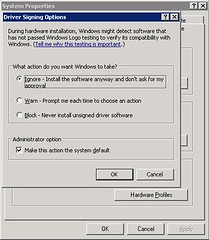
Once you do this, you’ll be able to mount VHD files without any further errors.
There’s going to be a new
Recently someone I one told me he was working with WebParts and that he was not happy about it.
Developing WebParts is that hard but is even easier if you are familiar with simple web user controls.
Some people from Reflection IT created a WebPart that allows you to reuse your web user controls. So I think it will very useful for anyone that is just starting with this
Just look for
SmartPartCheers!